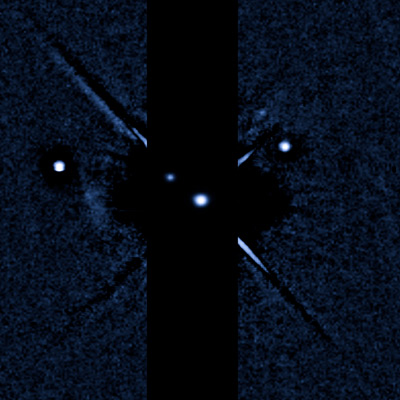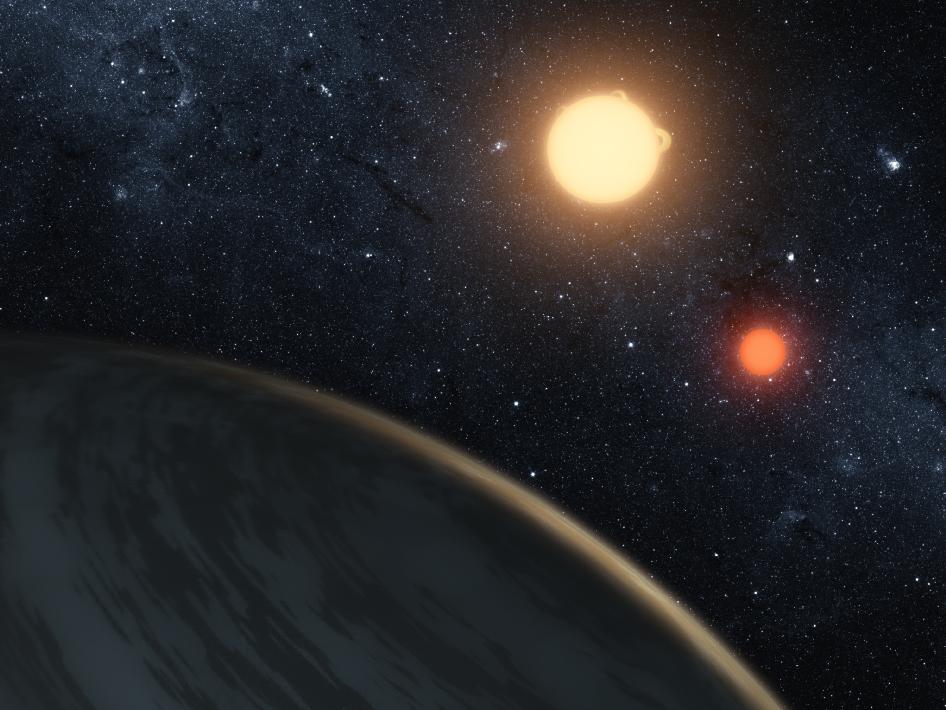







| BOOKS | F. A. Q. | ARTICLES | TALKS | ABOUT KEN | DONATE | BEYOND OUR KEN |
|---|
By Ken Croswell
Published on ScienceNOW (June 6, 2012)


Plutonic relationships: Pluto and its moons (left) may show how planets orbit double stars such as Kepler 16 (right).
Credit: (left) NASA, ESA, and M. Showalter (SETI Institute); (right) NASA/JPL-Caltech/T. Pyle.
Planet or not, Pluto and its newest moons may tell us a lot about how other worlds orbit distant stars. A new computer simulation based on the motions of Pluto's satellites not only zeroes in on the masses of two of the moons but predicts that planets orbiting double stars are more widely spaced from one another than are the worlds of single stars such as the Sun.
Once thought to be a lonely outpost at the solar system's edge, Pluto now has four known moons. The first, discovered in 1978 and named Charon, is half Pluto's size. The Hubble Space Telescope spotted two more, Nix and Hydra, in 2005, orbiting beyond Charon, then another in 2011. In mythology, Pluto was the god of the underworld, so the names of the satellites reflect the same dark theme: Charon ferried souls of the dead across the River Styx; Nix was the goddess of night; and Hydra was a nine-headed monster who lived in a lake near an underworld entrance.
Now astronomers Andrew Youdin, Kaitlin Kratter, and Scott Kenyon of the Harvard-Smithsonian Center for Astrophysics in Cambridge, Massachusetts, have analyzed Pluto's newest moon, which does not yet have a permanent name. It's the smallest of the bunch and moves between the orbits of Nix and Hydra.
"The more massive Nix and Hydra are, the stronger they push this other moon around," says Youdin, who used a computer to simulate the satellites' motions for 30 million years in order to deduce their properties. As the scientists will report in the August 1, 2012, issue of The Astrophysical Journal, Nix and Hydra must be less than about a millionth as massive as Earth's Moon or else their gravity would tear away the smallest satellite. That still means the two satellites could be several times more massive than the larger moon of Mars, Phobos. If made of ice, Nix and Hydra are less than 46 and 56 kilometers across, respectively.
Nix, Hydra, and the new moon don't actually orbit Pluto; they circle the center of mass of Pluto and Charon, because Charon is 12 percent as massive as Pluto. Thus, Pluto and Charon resemble a double star, and the three other moons are like planets going around them. Last year, NASA's Kepler spacecraft discovered the first definite planet orbiting a double sun, Kepler 16.
The simulations of Pluto's moons therefore carry implications for planetary systems around double stars. "Stability is much more delicate than it is around a single star," says Youdin. "There's more jostling going on, and so in order for the system to be stable for a long time, the planetary separations need to be wider."
Kepler has not yet found a double star sporting more than one planet--but astronomer Daniel Fabrycky of the University of California, Santa Cruz, says that such a discovery is imminent and that Youdin and his colleagues make a definite prediction which Kepler will either confirm or refute. "What they have done is tell us that we shouldn't expect planets of binary stars to have quite the same properties as systems of planets orbiting single stars," he says. "The planets should be more spread out from each other and give each other more dynamical room."
NASA's New Horizons spacecraft will reach Pluto in 2015, testing the predictions about Nix and Hydra. The spacecraft's initials, NH, were another reason Nix and Hydra received the names they did, just as the first two letters of Pluto honor Percival Lowell, the astronomer who searched for the far-off world but died fourteen years before Clyde Tombaugh, working at Lowell Observatory, ultimately succeeded in finding it.
Ken Croswell earned his Ph.D. in astronomy from Harvard University and is the author of The Alchemy of the Heavens and The Lives of Stars.
"An engaging account of the continuing discovery of our Galaxy...wonderful." --Owen Gingerich, The New York Times Book Review. See all reviews of The Alchemy of the Heavens here.
"A stellar picture of what we know or guess about those distant lights."--Kirkus. See all reviews of The Lives of Stars here.
| BOOKS | F. A. Q. | ARTICLES | TALKS | ABOUT KEN | DONATE | BEYOND OUR KEN |
|---|